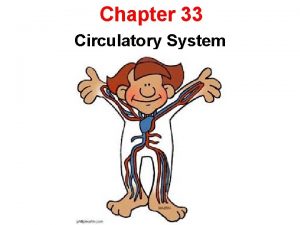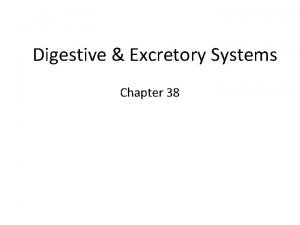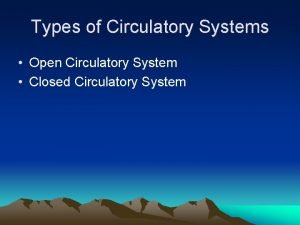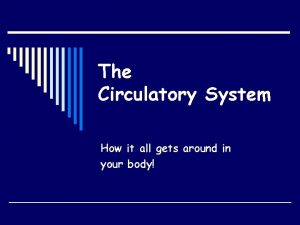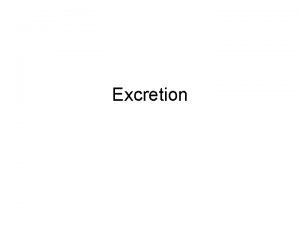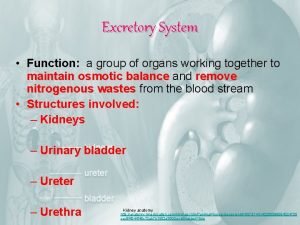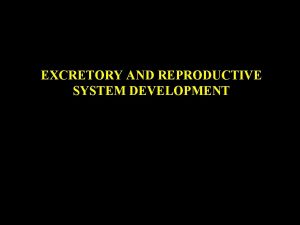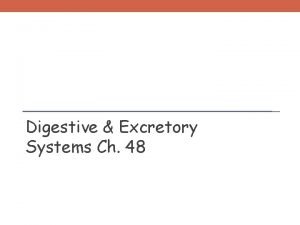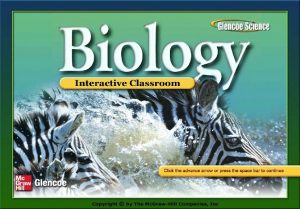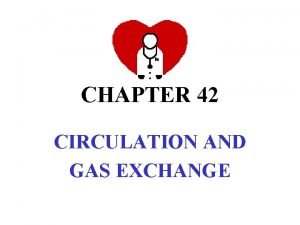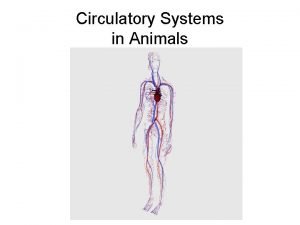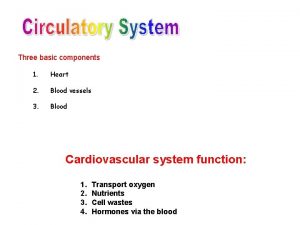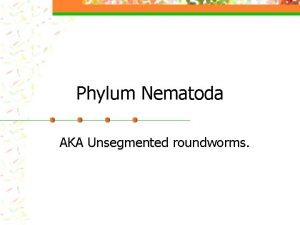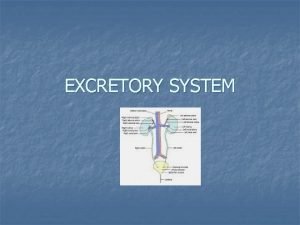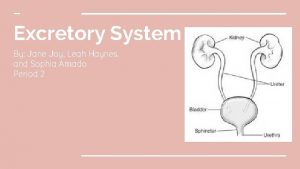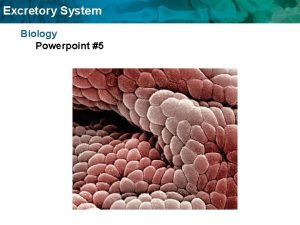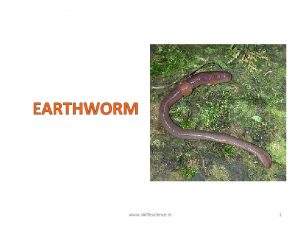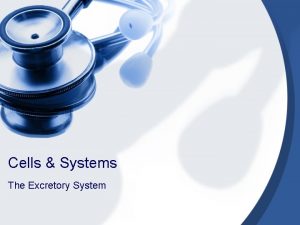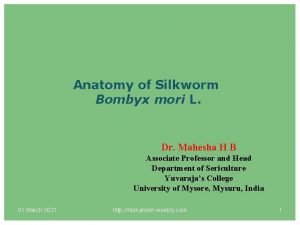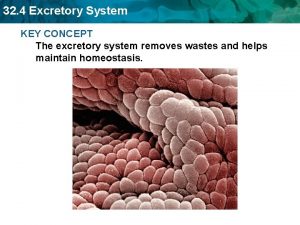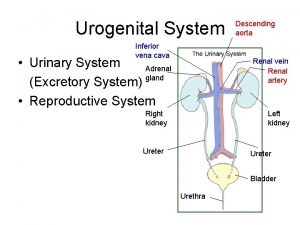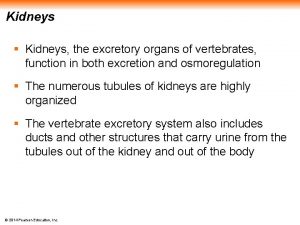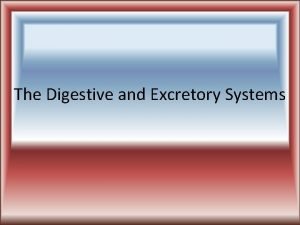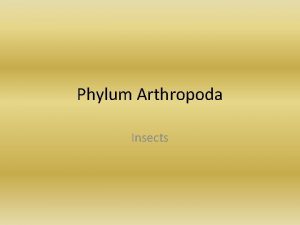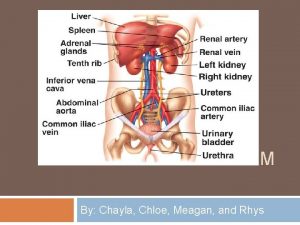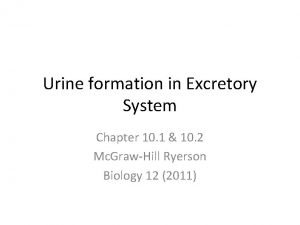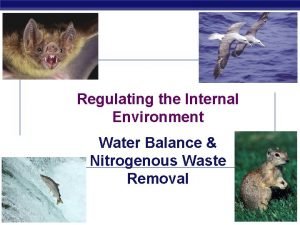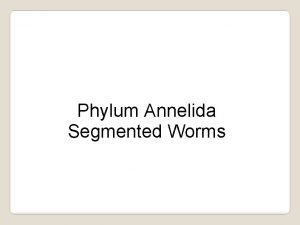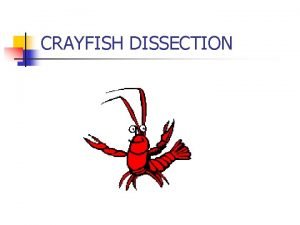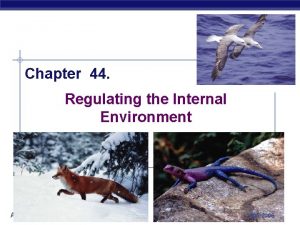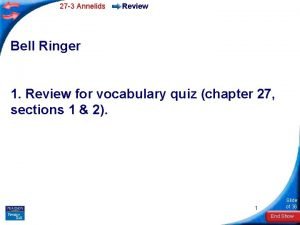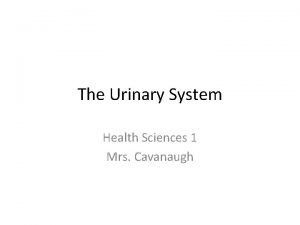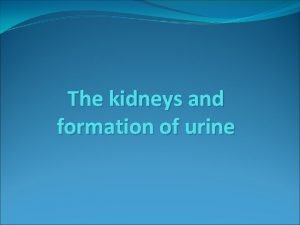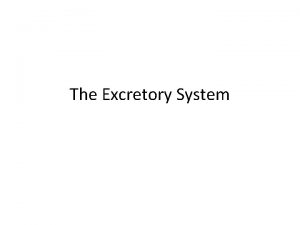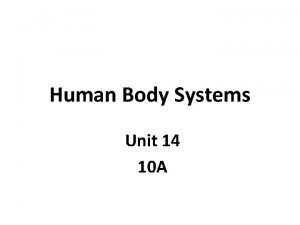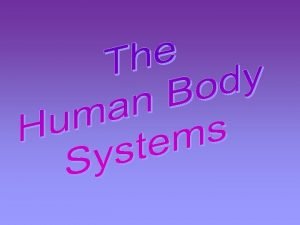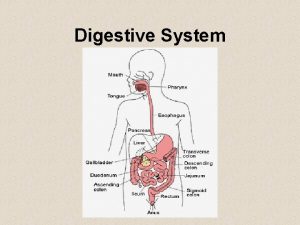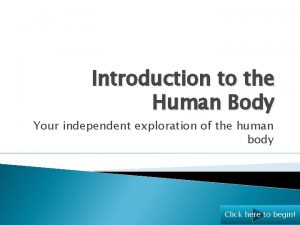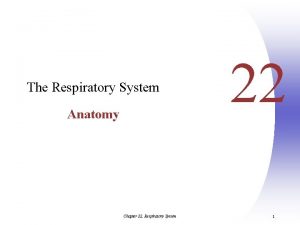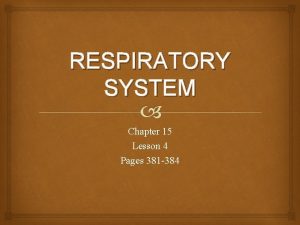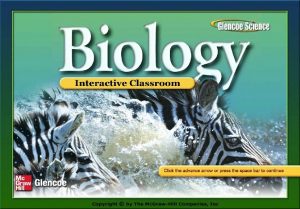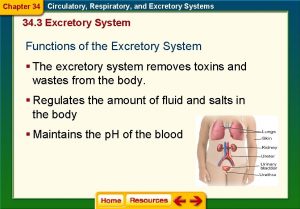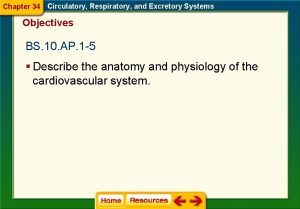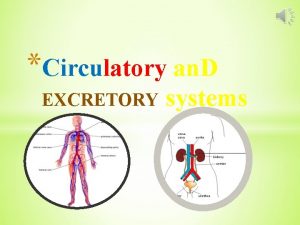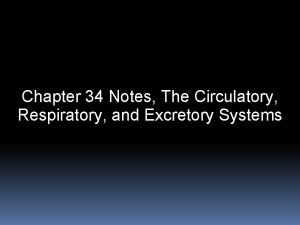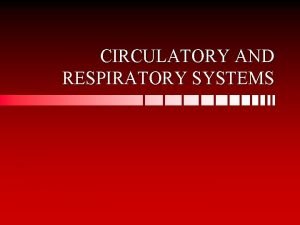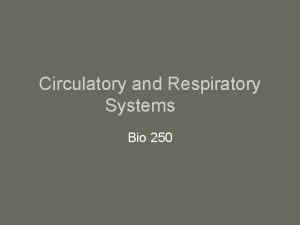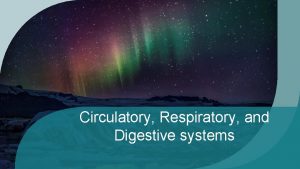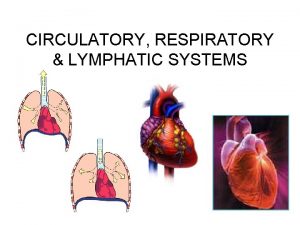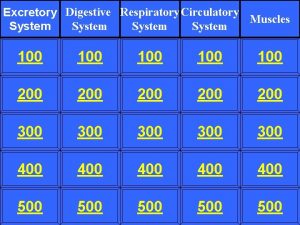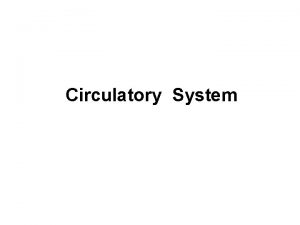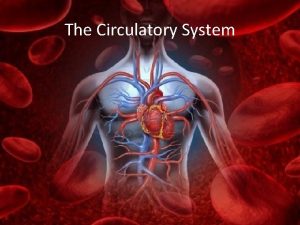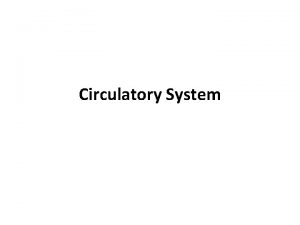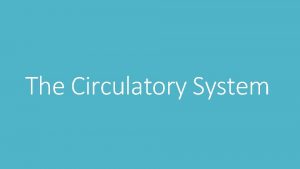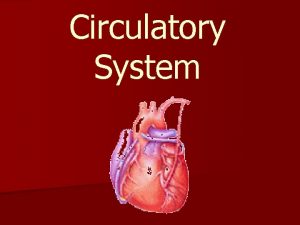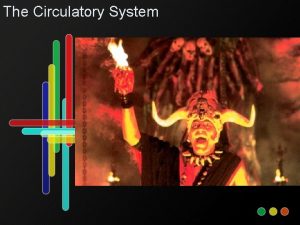Chapter 34 Circulatory Respiratory and Excretory Systems Section








































































- Slides: 72


Chapter 34 Circulatory, Respiratory, and Excretory Systems Section 1: Circulatory System Section 2: Respiratory System Section 3: Excretory System Click on a lesson name to select.

Chapter 34 Circulatory, Respiratory, and Excretory Systems 34. 1 Circulatory System Functions of the Circulatory System § Transports oxygen and nutrients § Carries disease-fighting materials produced by the immune system § Contains cell fragments and proteins for blood clotting § Distributes heat throughout the body to help regulate body temperature

Chapter 34 Circulatory, Respiratory, and Excretory Systems 34. 1 Circulatory System Blood Vessels § Arteries § Capillaries § Veins

Chapter 34 Circulatory, Respiratory, and Excretory Systems

Chapter 34 Circulatory, Respiratory, and Excretory Systems 34. 1 Circulatory System Arteries § Oxygen-rich blood is carried away from the heart. § Arteries are composed of three layers: § Outer layer of connective tissue § Middle layer of smooth muscle § Inner layer of endothelial tissue

Chapter 34 Circulatory, Respiratory, and Excretory Systems 34. 1 Circulatory System Capillaries § Microscopic blood vessels where the exchange of important substances and wastes occur § The walls are only one cell thick.

Chapter 34 Circulatory, Respiratory, and Excretory Systems 34. 1 Circulatory System Veins § Carry oxygen-poor blood back to the heart § Contraction of skeletal muscles helps keep the blood moving.

Chapter 34 Circulatory, Respiratory, and Excretory Systems 34. 1 Circulatory System The Heart § A hollow, muscular organ that pumps blood throughout the body § Pumps oxygenated blood to the body § Pumps deoxygenated blood to the lungs

Chapter 34 Circulatory, Respiratory, and Excretory Systems 34. 1 Circulatory System Structure of the Heart § Divided into four compartments called chambers § The right atrium and the left atrium receive blood returning to the heart. § The right and left ventricles pump blood away from the heart.

Chapter 34 Circulatory, Respiratory, and Excretory Systems 34. 1 Circulatory System § A strong muscular wall separates the left side of the heart from the right side of the heart. § Valves separate the atria from the ventricles and keep blood flowing in one direction.

Chapter 34 Circulatory, Respiratory, and Excretory Systems 34. 1 Circulatory System

Chapter 34 Circulatory, Respiratory, and Excretory Systems 34. 1 Circulatory System How the Heart Beats § The atria fill with blood. § The atria contract, filling the ventricles with blood. § The sinoatrial (SA) node sends out signals that cause both atria to contract. § The signal travels to another area in the heart called the atrioventricular node, causing both ventricles to contract.

Chapter 34 Circulatory, Respiratory, and Excretory Systems 34. 1 Circulatory System Pulse § The alternating expansion and relaxation of the artery wall caused by contraction of the left ventricle Blood Pressure § A measure of how much pressure is exerted against the vessel walls by the blood Blood Pressure

Chapter 34 Circulatory, Respiratory, and Excretory Systems 34. 1 Circulatory System § Deoxygenated blood flows from the right atrium into the right ventricle and is pumped into the pulmonary arteries that lead to the lungs. § Oxygenated blood flows from the lungs to the left atrium of the heart.

Chapter 34 Circulatory, Respiratory, and Excretory Systems

Chapter 34 Circulatory, Respiratory, and Excretory Systems 34. 1 Circulatory System § The blood moves from the left atrium into the left ventricle, which pumps the blood into the largest artery in the body, the aorta. § Oxygen is released from the blood into the body cells by diffusion, and carbon dioxide moves from the cells to the blood by diffusion.

Chapter 34 Circulatory, Respiratory, and Excretory Systems 34. 1 Circulatory System Plasma § Carries glucose, fats, vitamins, minerals, hormones, and waste products from the cells

Chapter 34 Circulatory, Respiratory, and Excretory Systems 34. 1 Circulatory System Red Blood Cells § Carry oxygen to all of the body’s cells § Consist of an iron-containing protein called hemoglobin § Hemoglobin chemically binds with oxygen molecules and carries oxygen to the body’s cells.

Chapter 34 Circulatory, Respiratory, and Excretory Systems 34. 1 Circulatory System Platelets § Collect and stick to the vessel at the site of the wound § Release chemicals that produce a protein called fibrin § Fibrin is a protein that weaves a network of fibers across the cut that traps blood platelets and red blood cells.

Chapter 34 Circulatory, Respiratory, and Excretory Systems 34. 1 Circulatory System White Blood Cells § Recognize disease-causing organisms § Produce chemicals to fight the invaders § Surround and kill the invaders

Chapter 34 Circulatory, Respiratory, and Excretory Systems 34. 1 Circulatory System Blood Types § There are four types of blood—A, B, AB, and O. Rh Factor § Another marker found on the surface of red blood cells

Chapter 34 Circulatory, Respiratory, and Excretory Systems

Chapter 34 Circulatory, Respiratory, and Excretory Systems 34. 2 Respiratory System Breathing and Respiration § The respiratory system sustains cellular respiration by supplying oxygen to body cells and removing carbon dioxide waste from cells. § Breathing is the mechanical movement of air into and out of your lungs. § External respiration is the exchange of gases between the atmosphere and the blood. § Internal respiration is the exchange of gases between the blood and the body’s cells.

Chapter 34 Circulatory, Respiratory, and Excretory Systems 34. 2 Respiratory System The Path of Air § The respiratory system is made up of the nasal passages, pharynx, larynx, epiglottis, trachea, lungs, bronchioles, alveoli (al VEE uh li), and the diaphragm.

Chapter 34 Circulatory, Respiratory, and Excretory Systems 34. 2 Respiratory System § Air enters your mouth or nose. § Hairlike structures called cilia trap foreign particles from the air and sweep them toward the throat. § Filtered air then passes through the upper throat called the pharynx.

Chapter 34 Circulatory, Respiratory, and Excretory Systems 34. 2 Respiratory System § The epiglottis allows air to pass from the larynx to a long tube in the chest cavity called the trachea. § The trachea branches into two large tubes, called bronchi, which lead to the lungs.

Chapter 34 Circulatory, Respiratory, and Excretory Systems 34. 2 Respiratory System § Each bronchus branches into smaller tubes called bronchioles. § Each of these small tubes continues to branch into even smaller passageways, which end in individual air sacs called alveoli.

Chapter 34 Circulatory, Respiratory, and Excretory Systems 34. 2 Respiratory System Breathing § Inhalation is the act of taking air into the lungs. § The diaphragm contracts, causing the chest cavity to expand as the diaphragm moves down.

Chapter 34 Circulatory, Respiratory, and Excretory Systems 34. 2 Respiratory System § During exhalation, the diaphragm relaxes and returns to its normal resting position. § This reduces the size of the chest cavity as the diaphragm moves up. Visualizing Gas Exchange

Chapter 34 Circulatory, Respiratory, and Excretory Systems 34. 2 Respiratory System

Chapter 34 Circulatory, Respiratory, and Excretory Systems

Chapter 34 Circulatory, Respiratory, and Excretory Systems 34. 3 Excretory System Functions of the Excretory System § The excretory system removes toxins and wastes from the body. § Regulates the amount of fluid and salts in the body § Maintains the p. H of the blood

Chapter 34 Circulatory, Respiratory, and Excretory Systems 34. 3 Excretory System Parts of the Excretory System § The components that make up the excretory system include the lungs, skin, and kidneys.

Chapter 34 Circulatory, Respiratory, and Excretory Systems 34. 3 Excretory System The Kidneys § Bean shaped organs that filter out wastes, water, and salts from the blood § Renal cortex § Renal medulla § Renal pelvis

Chapter 34 Circulatory, Respiratory, and Excretory Systems 34. 3 Excretory System Nephron Filtration § Each kidney contains approximately one million filtering units called nephrons. § The renal artery transports nutrients and wastes to the kidney.

Chapter 34 Circulatory, Respiratory, and Excretory Systems

Chapter 34 Circulatory, Respiratory, and Excretory Systems 34. 3 Excretory System Reabsorption and the Formation of Urine § The filtrate flows through the loop of Henle and the collecting tubule. § Glucose and minerals are reabsorbed back into the capillaries surrounding the renal tubule. § Urine, which is excess fluids and wastes, leaves the kidneys through ducts called the ureters. § Urine is stored in the urinary bladder and exits the body through the urethra.

Chapter 34 Circulatory, Respiratory, and Excretory Systems 34. 3 Excretory System Kidney Disorders

Chapter 34 Circulatory, Respiratory, and Excretory Systems

Chapter 34 Circulatory, Respiratory, and Excretory Systems Chapter Resource Menu Chapter Diagnostic Questions Formative Test Questions Chapter Assessment Questions Standardized Test Practice biologygmh. com Glencoe Biology Transparencies Image Bank Vocabulary Animation Click on a hyperlink to view the corresponding lesson.

Chapter 34 Circulatory, Respiratory, and Excretory Systems Chapter Diagnostic Questions Identify the structures that carry blood away from the heart. A. valves B. veins C. arteries D. capillaries

Chapter 34 Circulatory, Respiratory, and Excretory Systems Chapter Diagnostic Questions True or False Only veins have valves to prevent backward flow of blood.

Chapter 34 Circulatory, Respiratory, and Excretory Systems Chapter Diagnostic Questions Name the blood component that is helpful in clotting. A. platelets B. plasma C. red blood cells D. white blood cells

Chapter 34 Circulatory, Respiratory, and Excretory Systems 34. 1 Formative Questions Which is a vein?

Chapter 34 Circulatory, Respiratory, and Excretory Systems 34. 1 Formative Questions Which blood vessels have valves that prevent blood from flowing backward? A. arteries B. arterioles C. veins D. venules

Chapter 34 Circulatory, Respiratory, and Excretory Systems 34. 1 Formative Questions Which node is the pacemaker for the heart?

Chapter 34 Circulatory, Respiratory, and Excretory Systems 34. 1 Formative Questions Which blood component carries most of the carbon dioxide produced in the body’s cells? A. hemoglobin B. plasma C. platelets D. red blood cells

Chapter 34 Circulatory, Respiratory, and Excretory Systems 34. 2 Formative Questions Which is not one of the defenses against foreign materials entering the lungs? A. cilia B. mucous C. nose hairs D. trachea

Chapter 34 Circulatory, Respiratory, and Excretory Systems 34. 2 Formative Questions How is oxygen and carbon dioxide transported into and out of cells? A. by diffusion B. by osmosis C. by active transport D. by membrane pumps

Chapter 34 Circulatory, Respiratory, and Excretory Systems 34. 2 Formative Questions What causes inhalation of air to the lungs? A. Rib and diaphragm muscles contract. B. Rib and diaphragm muscles relax.

Chapter 34 Circulatory, Respiratory, and Excretory Systems 34. 2 Formative Questions What internal stimulus causes breathing rate to increase? A. a high concentration of O 2 in the blood B. a high concentration of CO 2 in the blood C. a low concentration of O 2 in the blood D. a low concentration of CO 2 in the blood

Chapter 34 Circulatory, Respiratory, and Excretory Systems 34. 2 Formative Questions Which is an example of internal respiration? A. Air in the lung moves into and out of alveoli. B. Carbon dioxide is carried from body tissues to the lungs. C. Oxygen in alveoli diffuses into red blood D. cells. Oxygen in red blood cells diffuses into tissue cells.

Chapter 34 Circulatory, Respiratory, and Excretory Systems 34. 3 Formative Questions What is the role of the skin in the excretory system? A. It controls levels of CO 2 and other gases. B. It excretes water and salts. C. It regulates the p. H of the blood. D. It removes minerals and urea.

Chapter 34 Circulatory, Respiratory, and Excretory Systems 34. 3 Formative Questions How do the kidneys help maintain p. H homeostasis in the body? A. by adjusting the balance of electrolytes in urine B. by excreting hydrogen ions and reabsorbing buffers C. by increasing or decreasing the reabsorption of water D. by regulating the level of carbon dioxide in the blood

Chapter 34 Circulatory, Respiratory, and Excretory Systems 34. 3 Formative Questions What condition results from crystallization of mineral compounds in the kidney? A. Bowman’s disorder B. kidney stones C. nephritis D. polycystic disease

Chapter 34 Circulatory, Respiratory, and Excretory Systems 34. 3 Formative Questions What is the immediate result of kidney failure? A. Fluid-filled cysts grow in the kidney. B. The body rejects the kidney. C. The urinary tract becomes blocked. D. Waste products build up in the blood.

Chapter 34 Circulatory, Respiratory, and Excretory Systems Chapter Assessment Questions Sequence the flow of blood through the heart beginning with the right atrium. Answer: Deoxygenated blood flows from the right atrium to the right ventricle, and then to the lungs and back to the left atrium and into the left ventricle which pumps oxygen-rich blood to the body and returns to the right atrium.

Chapter 34 Circulatory, Respiratory, and Excretory Systems Chapter Assessment Questions Which is not true of red blood cells? A. live for about 120 days B. fight disease C. develop in the marrow D. have no nuclei

Chapter 34 Circulatory, Respiratory, and Excretory Systems Chapter Assessment Questions What structure contracts during inhalation? A. bronchi B. diaphragm C. ribs D. pharynx

Chapter 34 Circulatory, Respiratory, and Excretory Systems Standardized Test Practice Which heart chamber is responsible for the pulse you can feel in your wrist? A. left atrium B. left ventricle C. right atrium D. right ventricle

Chapter 34 Circulatory, Respiratory, and Excretory Systems Standardized Test Practice Which two blood vessels are veins? (Two answers)

Chapter 34 Circulatory, Respiratory, and Excretory Systems Standardized Test Practice Which two blood vessels carry oxygenated blood? (Two answers)

Chapter 34 Circulatory, Respiratory, and Excretory Systems Standardized Test Practice Why should a girl with type A blood not receive a transfusion of type AB blood? A. She has A markers on her blood cells. B. She has A and B markers on her blood C. cells. She has Anti-A antibodies in her blood plasma. D. She has Anti-B antibodies in her blood plasma.

Chapter 34 Circulatory, Respiratory, and Excretory Systems Standardized Test Practice Where is urea filtered out of the blood?

Chapter 34 Circulatory, Respiratory, and Excretory Systems Standardized Test Practice What is the function of the convoluted tubule and the Loop of Henle? A. accumulate urea and toxins B. filter out sugars and proteins C. reabsorb water and glucoset D. store salts and minerals

Chapter 34 Circulatory, Respiratory, and Excretory Systems Glencoe Biology Transparencies

Chapter 34 Circulatory, Respiratory, and Excretory Systems Image Bank

Chapter 34 Circulatory, Respiratory, and Excretory Systems Vocabulary Section 1 artery red blood cell capillary vein valve heart pacemaker plasma platelet white blood cell atherosclerosis

Chapter 34 Circulatory, Respiratory, and Excretory Systems Vocabulary Section 2 breathing external respiration internal respiration trachea bronchus lung alveolus

Chapter 34 Circulatory, Respiratory, and Excretory Systems Vocabulary Section 3 kidney urea

Chapter 34 Circulatory, Respiratory, and Excretory Systems Animation § Arteries, Capillaries, and Veins § Circulatory System § Visualizing Gas Exchange § Kidney Filtration
 Chapter 33 section 1 the circulatory system
Chapter 33 section 1 the circulatory system Circulatory system and respiratory system work together
Circulatory system and respiratory system work together Digestive respiratory and circulatory system
Digestive respiratory and circulatory system Circulatory and respiratory system working together
Circulatory and respiratory system working together Chapter 38 digestive and excretory systems
Chapter 38 digestive and excretory systems How respiratory system work with circulatory system
How respiratory system work with circulatory system Chapter 34 section 2 the respiratory system
Chapter 34 section 2 the respiratory system Conducting zone respiratory
Conducting zone respiratory Clam open circulatory system
Clam open circulatory system Circulatory system interactions with other systems
Circulatory system interactions with other systems Functions of the digestive system
Functions of the digestive system Section 38-3 the excretory system
Section 38-3 the excretory system Section 38-3 the excretory system
Section 38-3 the excretory system Chapter 20 urinary/excretory system
Chapter 20 urinary/excretory system The circulatory or cardiovascular system chapter 19
The circulatory or cardiovascular system chapter 19 What are the functions of excretory system
What are the functions of excretory system Excretory and integumentary system
Excretory and integumentary system Excretory and reproductive system
Excretory and reproductive system Digestive and excretory system
Digestive and excretory system Chapter 36 section 1: reproductive systems answer key
Chapter 36 section 1: reproductive systems answer key Difference between open and closed circulatory system
Difference between open and closed circulatory system Amphibian and reptile circulatory system
Amphibian and reptile circulatory system 3 main functions heart
3 main functions heart Study guide chapter 10 section 1 meiosis
Study guide chapter 10 section 1 meiosis Mammalian excretory system
Mammalian excretory system Urinary structure
Urinary structure Phylum nematoda excretory system
Phylum nematoda excretory system What does the excretory system do
What does the excretory system do Which is excretory organ
Which is excretory organ 5 facts about the excretory system
5 facts about the excretory system Major functions of the excretory system
Major functions of the excretory system Excretory function of lungs
Excretory function of lungs Juxtaposing in earthworm
Juxtaposing in earthworm Allantoic stalk fetal pig
Allantoic stalk fetal pig 5 facts about the excretory system
5 facts about the excretory system Birds excretory system
Birds excretory system Silkworm diagram
Silkworm diagram Process of excretion
Process of excretion Excretory system quizziz
Excretory system quizziz Inferior vena cava urinary system
Inferior vena cava urinary system Excretory system of vertebrates
Excretory system of vertebrates Excretory system song
Excretory system song Objectives of digestive system
Objectives of digestive system Subphylum of grasshopper
Subphylum of grasshopper Excretory system
Excretory system Excretory system
Excretory system Mammalian excretory system
Mammalian excretory system Mammalian excretory system
Mammalian excretory system Earthworm cross section
Earthworm cross section Excretory system of insects
Excretory system of insects Body cavities
Body cavities Crayfish excretory system
Crayfish excretory system Mammalian excretory system
Mammalian excretory system Excretory
Excretory Voiding of bladder
Voiding of bladder Where does secretion occur in the nephron
Where does secretion occur in the nephron Excretory system
Excretory system Non excretory function of kidney
Non excretory function of kidney Excretory system of nematodes
Excretory system of nematodes Excretory system functions
Excretory system functions Kidneys are part of the excretory system in a human body
Kidneys are part of the excretory system in a human body Kidney diagram class 10
Kidney diagram class 10 Hagfish excretory system
Hagfish excretory system Malfunctions of the excretory system
Malfunctions of the excretory system Homework
Homework Small intestine parts
Small intestine parts Excretory system crossword puzzle
Excretory system crossword puzzle Integumentary system analogy
Integumentary system analogy Decision support systems and intelligent systems
Decision support systems and intelligent systems The human respiratory system chapter 7 handout
The human respiratory system chapter 7 handout Chapter 13 the respiratory system
Chapter 13 the respiratory system Respory
Respory Chapter 15 respiratory system
Chapter 15 respiratory system
